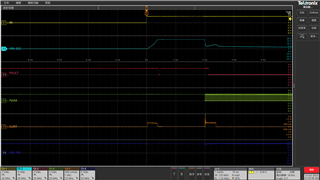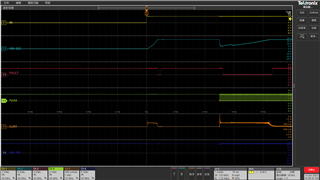Hi Experts,
I am following the question about this one:
I want to describe the issue again, please see the test environment:
18V_PRI is input voltage to TPS1H200A
18_SEC is the output voltage of TPS1H200A
IN is the IN of TPS1H200A
Current is sense by current sensor
Fault is the fault output of TPS1H200A
PWM is the flyabck working signal, it's meaning that the load is connected to the power bus
When the delay capacitor is 4.7nF, in latch-off mode, total delay time is tcl+tdl1+tdl2= 2.3ms. See the test waveform below:
In 0s, when the first current limitation occur and just continue 0.5ms , the fault just down for 0.1ms then go to high level.
In 2ms, now the time is less than 2.3ms, when the second current limitation occur and fault is down to low level and the output of TPS1H200A keep disable.

But if the second current limitation gap longer, the action of TPS1H200A is different:
In 0s, when the first current limitation occur and just continue 0.5ms , the fault just down for 0.1ms then go to high level.
In 2.5ms, now the time is longer than 2.3ms, when the second current limitation occur and fault is down to low level, the second current limitation continue less than 2.3ms, the fault will go back to high level.

Could you comment on that? Customer has modified the power on sequence on the product, all the product are meet second picture waveform. Thanks.
Best Regards
Songzhen Guo


